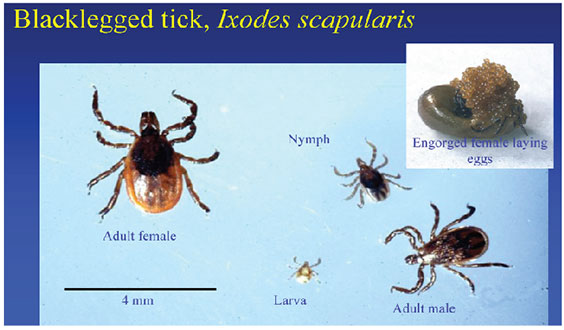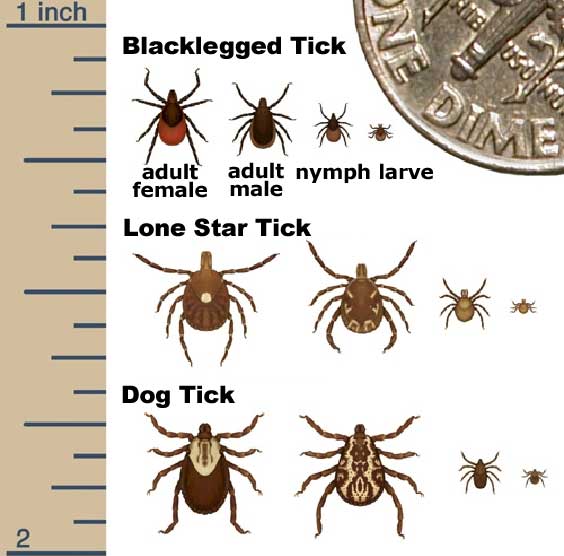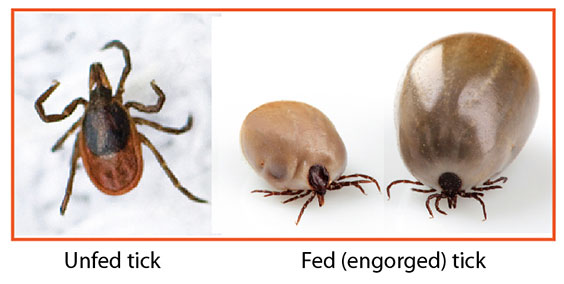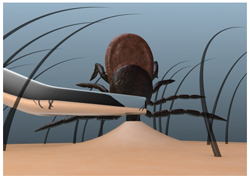Insect Bites and Diseases
Ticks
For the past 5 years the number of reported cases of Lyme Disease has varied based, in part, on the moisture levels during the spring, summer and fall. Ticks need a moist environment to survive. There is a consistent upward trend in the number of new reported people with Lyme Disease. The actual number of cases is likely higher as the symptoms can be non-specific, the sensitivity of testing in the first month is not high, and there is likely underreporting. Nymphs need a blood meal in the spring/summer, and the adult females in the fall.



Identified risk areas for Lyme Disease include most of Lanark, Leeds, Grenville, and many of the southern parts of the province. See Ontario Lyme Disease Risk Areas Map 2021.

The black-legged tick or deer tick is now commonly found in our area. Climate Change has added to this risk with warmer temperatures that allow ticks to survive, multiply, travel farther and may carry more diseases. Some of these ticks carry the bacteria responsible for causing Lyme Disease and Anaplasmosis. Ticks prefer to live in humid, wooded areas. Once temperatures rise above 4°C, ticks become active and begin to look for a blood meal. If an infected tick bites you and remains attached to you for over 24 hours you may be at an increased risk of getting Lyme disease. Lyme disease is preventable. Although the blacklegged tick is our current concern, it is important to know there are many types of ticks that can spread other diseases to people through bites. The Health Unit actively monitors for emerging ticks and tick diseases. The following sections will help you enjoy the outdoors while protecting you and your family from ticks:
- Keeping the grass in your yard mowed and removing leaf litter and brush from the edges of your property (especially if it borders natural areas).
- Creating a natural physical separation between your yard and wooded areas using a border of wood chips or gravel.
- Cleaning up areas under and around bird feeders to reduce the attraction of small critters such as mice that help transport ticks and are necessary hosts for ticks to complete their life cycle.
- Placing children’s play structures away from wooded areas.
- When weather permits, wear long sleeves and long pants and closed-toe shoes to ensure your skin is covered.
- Wear light coloured clothing as it allows you to spot ticks that may have crawled on you.
- Tuck pants into socks to prevent ticks from crawling up your legs if you are going to be hiking through the bush.
- Insect repellents containing DEET or Icaridin can be sprayed on clothing or skin to repel ticks (be sure to follow the manufacturer’s instructions for safe use).
- Stay on the groomed part of trails where there is no vegetation for ticks to hide on.
- Do a complete tick check of your entire body when you return from the outdoors and have someone check the back side of you.
- A quick shower may help wash away ticks that have not yet attached.
- Outdoor wear can be placed in the drier for a few minutes to kill ticks.
- Speak to your vet about ways to protect your pets.
Learn to Recognize Ticks




What to Do If You Find a Tick On You

Keep these tips in mind:
- Don’t panic.
- Remove the tick using tweezers or a tick puller, by grasping the tick by the head as close to your skin as possible. Pull on it firmly, but gently and straight out.
- Examine the tick to see if it is flat or fat. If it is flat is has likely been on you less than 24 hours and it is unlikely that if it was a positive tick that it would transmit the bacteria.
- If the tick is fat it is likely that it has been attached to you and feeding for more than 24 hours and you may be at a higher risk of getting Lyme disease so consult with your health care provider.
- Clean and disinfect the site of the bite.
- Make a note of the date you removed the tick – early symptoms of Lyme disease appear from 3 days to 30 days following the tick bite and may include a red rash, a bulls-eye rash, fever, headache, fatigue, muscle and joint pain. These early symptoms may disappear without treatment; however the disease can move into the next stage where it may be more difficult to treat.
Mosquitoes
Mosquitoes are commonly found in our area and lay their eggs in stagnant water. While most mosquitoes are annoying and cause skin irritation when they bite; some mosquitoes carry and transmit diseases such as West Nile Virus (WNV), Jamestown Canyon Virus and Eastern Equine Encephalitis (EEE). Many of these mosquito diseases are found in wildlife, but people are exposed when they are bitten by infected mosquitoes. Mosquitoes do not travel very far, so those biting you around your property are likely finding suitable conditions in your yard. The following information will help you prevent exposure to mosquitoes:
- Remove standing water from things that can collect water like bird baths, old tires, flower pot saucers, gutters, children’s toys.
- Keep decorative ponds from becoming stagnant.
- Keep bushes and shrubs trimmed.
- Keep compost piles turned regularly.
- Keep ditches free of debris so they can drain properly.
- Keep pools and wading pools chlorinated.
- Ensure windows and doors are screened to keep mosquitoes out.
- Avoid outdoor activities in the early morning and evening when mosquitoes are most active and if you have to be out cover up and use insect repellent.
- Wear long-sleeved shirts, long pants and socks when outdoors during these active times.
- Use bug nets over strollers and playpens and screened tents when spending time outdoors.
- Apply insect repellent to any exposed skin, sparingly. The concentration of DEET should be no greater than 30% for adults and no greater than 10% for children. Carefully read and follow manufacturer’s directions for use.
- Do not apply repellent to children’s hands, or near any areas of mucous membrane such as the eyes or mouth.
- Consider spraying clothing with repellents containing permethrin, as mosquitoes easily bite through thin clothing such as cotton t-shirts.
- Special note when packing for camp: Check to see if aerosol sprays are allowed at your child’s camp. If sprays are not allowed, make sure you pack an insect repellent that can be applied by pump or by hand.
Related Links
- Tick Pamphlet
- Tick Poster
- Tick Presentation
- Let’s Talk Ticks Video
- Let’s Target Lyme Campaign
- Eastern Equine Encephalitis – US Centres for Disease Control and Prevention
- Eastern Equine Encephalitis – Ontario Fact Sheet for Animal Owners
- West Nile Virus – US Centres for Disease Control and Prevention
- West Nile Virus – Ontario Fact Sheet for Animal Owners
- Jamestown Canyon Virus
- Anaplasmosis